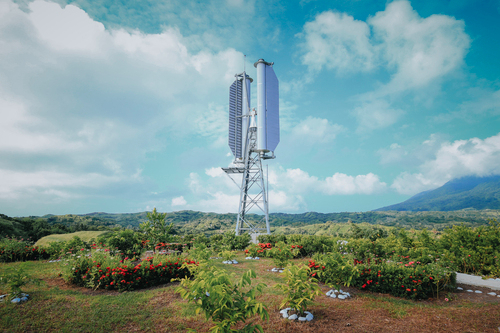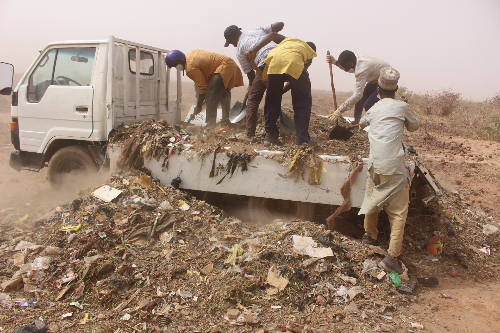J-STORIES - Wind power is a key part of the world’s shift to a renewable energy future. But conventional wind turbines are vulnerable to particularly strong winds, and can be halted, or even destroyed, by adverse conditions such as the fierce typhoons that buffet Japan each year.
Tokyo-based Challenergy is developing propeller-less turbines that can continue to generate electricity even during such severe weather. Indeed, the creators claim the turbines can withstand gales 1.5 times stronger than those that can bring conventional turbines to a standstill.
This added robustness means they can produce electricity not just in typhoon-afflicted countries such as Japan and the Philippines, but also in hurricane regions such as the Americas, or in parts of East Africa and the Pacific that are prone to cyclones.

Challenergy uses a proprietary blade-less design known as “Magnus Vertical Axis.” Instead of blades, the turbines developed by the outfit have large vertical tubes, two of them in the latest design.
They generate electricity via the Magnus effect, a phenomenon that occurs when a spinning object moves through a fluid, or air. It is the same phenomenon that causes a ball in baseball or tennis to curve when spin is applied.
Challenergy CEO Atsushi Shimizu first turned his attention to wind energy after the 2011 Fukushima nuclear disaster. He felt that society needed an energy source other than nuclear power, and that wind power would be a major part of the world’s renewable energy future.
The company aims to commercialize its turbines by 2025 and is now working on offshore versions. It also intends to develop large turbines that can generate 10 times as much electricity as its current models.
.jpg)
A key element of commercialization is maintenance. The turbines have a lifetime of 20 years and require regular checks. Challenergy has already established a maintenance company in the Philippines and plans to offer similar services in other markets.
According to the company’s CSO, Shigeto Mizumoto, because renewable energy uses natural elements such as the sun, wind, and water, conditions differ depending on the region. For that reason, one challenge is to develop technology that precisely meets the needs of each local environment, he says.
But as the world faces a stormy and uncertain future due to climate change, this new technology could be a way to turn fierce headwinds to our advantage.
Translation and Editing by Tony McNicol
Top page photo by Challenergy
For inquires about this article, please contact us at jstories@pacificbridge.jp
***
Click here for the Japanese version of the article.
![[Tokyo Updates] Is Hill-Farmed Salmon Here to Save Us?](https://storage.googleapis.com/jstories-cms.appspot.com/images/173258722885374_09952-thumb-1600xauto-10881_smallthumbnail.jpeg)
![[Tokyo Updates] Old and Full of Potential: Why a Swedish Model Is Reviving Abandoned Houses in Tokyo](https://storage.googleapis.com/jstories-cms.appspot.com/images/1732603609687d6b0a861ef75d954729578323092323fe00ad55e-thumb-1600xauto-10186_smallthumbnail.jpg)
![[Tokyo Updates] Making Space Development Open for All](https://storage.googleapis.com/jstories-cms.appspot.com/images/1732521298402c3af387cf9df027b91f0e9f2626b300713b93850-thumb-1600xauto-10594_smallthumbnail.jpg)

![[Podcast] Japanese technology to supercharge human fertility (Part 3)](https://storage.googleapis.com/jstories-cms.appspot.com/images/1766558713084place-for-scientific-research-2025-03-07-14-08-49-utc%20(1)_bigthumbnail.jpeg)
![[Interview: Part 2] A digital approach to tackle child hunger in Japan with dignity](https://storage.googleapis.com/jstories-cms.appspot.com/images/1766130666509unnamed_bigthumbnail.jpg)
![[Podcast] Japanese technology to supercharge human fertility (Part 2)](https://storage.googleapis.com/jstories-cms.appspot.com/images/1765863548035unnamed-7_bigthumbnail.jpg)
![[Podcast] Japanese technology to supercharge human fertility (Part 1)](https://storage.googleapis.com/jstories-cms.appspot.com/images/1765440905082unnamed_bigthumbnail.jpg)
_bigthumbnail.jpeg)





![[Interview] When digital and physical worlds meet](https://storage.googleapis.com/jstories-cms.appspot.com/images/1747974430456unnamed-2_smallthumbnail.png)




_smallthumbnail.jpeg)

![[Interview: Part 1] From nourishing souls to feeding the hungry](https://storage.googleapis.com/jstories-cms.appspot.com/images/1763695595492unnamed_smallthumbnail.jpg)

